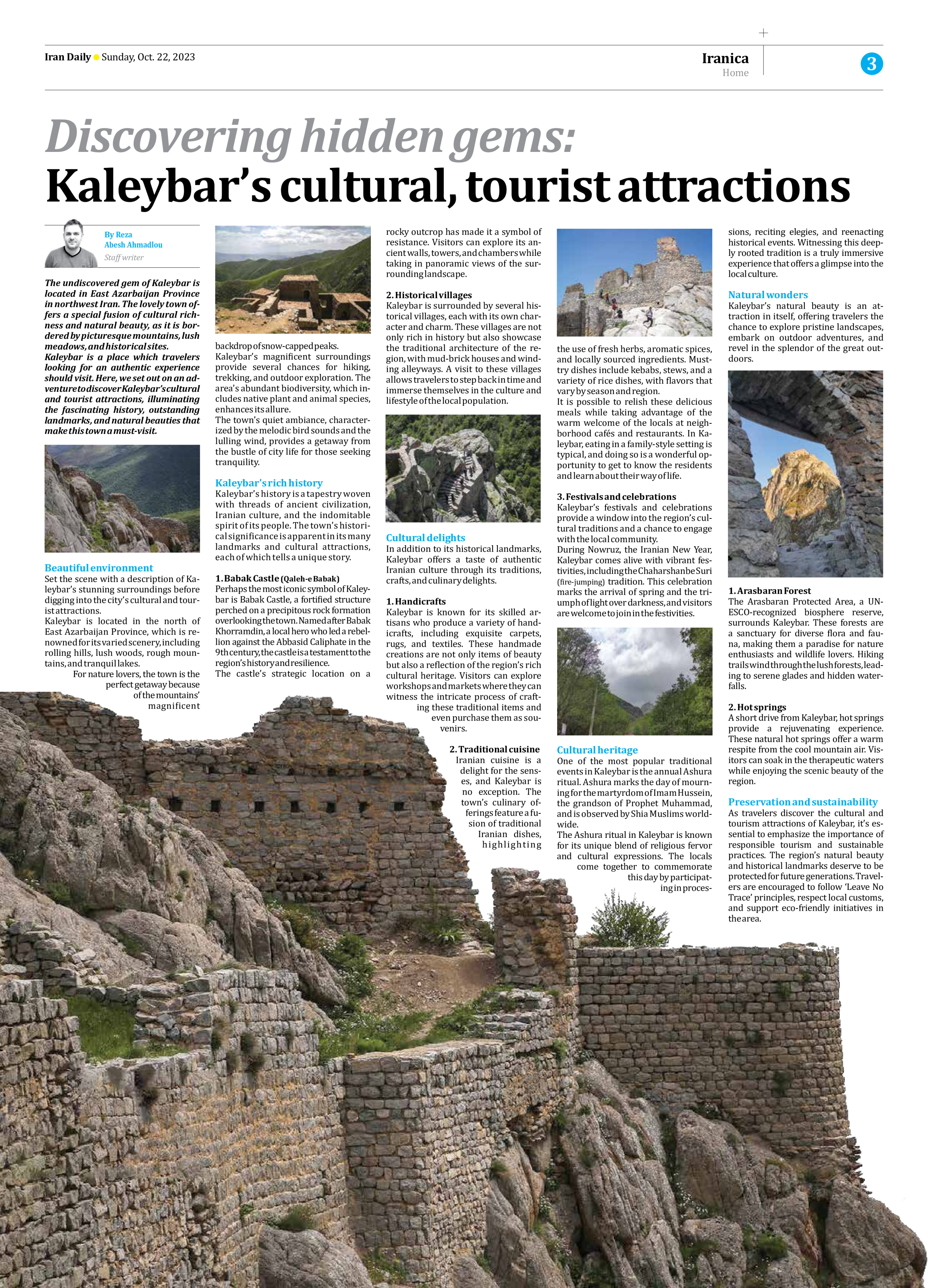
Discovering hidden gems:
Kaleybar’s cultural, tourist attractions
By Reza Abesh Ahmadlou
Staff writer
The undiscovered gem of Kaleybar is located in East Azarbaijan Province in northwest Iran. The lovely town offers a special fusion of cultural richness and natural beauty, as it is bordered by picturesque mountains, lush meadows, and historical sites.
Kaleybar is a place which travelers looking for an authentic experience should visit. Here, we set out on an adventure to discover Kaleybar’s cultural and tourist attractions, illuminating the fascinating history, outstanding landmarks, and natural beauties that make this town a must-visit.
Beautiful environment
Set the scene with a description of Kaleybar’s stunning surroundings before digging into the city’s cultural and tourist attractions.
Kaleybar is located in the north of East Azarbaijan Province, which is renowned for its varied scenery, including rolling hills, lush woods, rough mountains, and tranquil lakes.
For nature lovers, the town is the perfect getaway because of the mountains’ magnificent backdrop of snow-capped peaks.
Kaleybar’s magnificent surroundings provide several chances for hiking, trekking, and outdoor exploration. The area’s abundant biodiversity, which includes native plant and animal species, enhances its allure.
The town’s quiet ambiance, characterized by the melodic bird sounds and the lulling wind, provides a getaway from the bustle of city life for those seeking tranquility.
Kaleybar’s rich history
Kaleybar’s history is a tapestry woven with threads of ancient civilization, Iranian culture, and the indomitable spirit of its people. The town’s historical significance is apparent in its many landmarks and cultural attractions, each of which tells a unique story.
1. Babak Castle (Qaleh-e Babak)
Perhaps the most iconic symbol of Kaleybar is Babak Castle, a fortified structure perched on a precipitous rock formation overlooking the town. Named after Babak Khorramdin, a local hero who led a rebellion against the Abbasid Caliphate in the 9th century, the castle is a testament to the region’s history and resilience.
The castle’s strategic location on a rocky outcrop has made it a symbol of resistance. Visitors can explore its ancient walls, towers, and chambers while taking in panoramic views of the surrounding landscape.
2. Historical villages
Kaleybar is surrounded by several historical villages, each with its own character and charm. These villages are not only rich in history but also showcase the traditional architecture of the region, with mud-brick houses and winding alleyways. A visit to these villages allows travelers to step back in time and immerse themselves in the culture and lifestyle of the local population.
Cultural delights
In addition to its historical landmarks, Kaleybar offers a taste of authentic Iranian culture through its traditions, crafts, and culinary delights.
1. Handicrafts
Kaleybar is known for its skilled artisans who produce a variety of handicrafts, including exquisite carpets, rugs, and textiles. These handmade creations are not only items of beauty but also a reflection of the region’s rich cultural heritage. Visitors can explore workshops and markets where they can witness the intricate process of crafting these traditional items and even purchase them as souvenirs.
2. Traditional cuisine
Iranian cuisine is a delight for the senses, and Kaleybar is no exception. The town’s culinary offerings feature a fusion of traditional Iranian dishes, highlighting the use of fresh herbs, aromatic spices, and locally sourced ingredients. Must-try dishes include kebabs, stews, and a variety of rice dishes, with flavors that vary by season and region.
It is possible to relish these delicious meals while taking advantage of the warm welcome of the locals at neighborhood cafés and restaurants. In Kaleybar, eating in a family-style setting is typical, and doing so is a wonderful opportunity to get to know the residents and learn about their way of life.
3. Festivals and celebrations
Kaleybar’s festivals and celebrations provide a window into the region’s cultural traditions and a chance to engage with the local community.
During Nowruz, the Iranian New Year, Kaleybar comes alive with vibrant festivities, including the Chaharshanbe Suri (fire-jumping) tradition. This celebration marks the arrival of spring and the triumph of light over darkness, and visitors are welcome to join in the festivities.
Cultural heritage
One of the most popular traditional events in Kaleybar is the annual Ashura ritual. Ashura marks the day of mourning for the martyrdom of Imam Hussein, the grandson of Prophet Muhammad, and is observed by Shia Muslims worldwide.
The Ashura ritual in Kaleybar is known for its unique blend of religious fervor and cultural expressions. The locals come together to commemorate this day by participating in processions, reciting elegies, and reenacting historical events. Witnessing this deeply rooted tradition is a truly immersive experience that offers a glimpse into the local culture.
Natural wonders
Kaleybar’s natural beauty is an attraction in itself, offering travelers the chance to explore pristine landscapes, embark on outdoor adventures, and revel in the splendor of the great outdoors.
1. Arasbaran Forest
The Arasbaran Protected Area, a UNESCO-recognized biosphere reserve, surrounds Kaleybar. These forests are a sanctuary for diverse flora and fauna, making them a paradise for nature enthusiasts and wildlife lovers. Hiking trails wind through the lush forests, leading to serene glades and hidden waterfalls.
2. Hot springs
A short drive from Kaleybar, hot springs provide a rejuvenating experience. These natural hot springs offer a warm respite from the cool mountain air. Visitors can soak in the therapeutic waters while enjoying the scenic beauty of the region.
Preservation and sustainability
As travelers discover the cultural and tourism attractions of Kaleybar, it’s essential to emphasize the importance of responsible tourism and sustainable practices. The region’s natural beauty and historical landmarks deserve to be protected for future generations. Travelers are encouraged to follow ‘Leave No Trace’ principles, respect local customs, and support eco-friendly initiatives in the area.







